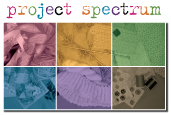
Each year as spring arrives, I think paint. What could be more exciting in the world of fiber art than not knowing what the alchemy of fabric paints, salts, gels, powdered pigments, sponges, brushes, and a little time will render? It’s a surprise every time and I love it!
For this fiber play, you will need some white Kona or pima 100% PFD (prepared for dying) cotton fabric, a sponge applicator, a dimensional plaster (or metal) decorative wall ornament, a bottle of Pebeo Setacolor transparent fabric paint, rubber gloves, plastic wrap, and some rock salt.

Commercial fabrics are often treated with finishes that will resist the absorption of paint. If you’re not sure whether your fabric is PFD, wash it first with Synthropol or a small amount of laundry detergent. Do not use fabric softener in the rinse water.
Additionally, fabric paint can permanently stain your clothing, so it’s a good idea to wear a protective cover over your clothes or older clothing designated just for this purpose.
When fabric painting, I use a foamcore board purchased from an art supply store as my base. It’s lightweight and easy to cover with a drop cloth, large trash bag, or vinyl. I also keep a spray bottle (filled with water) and paper towels handy.
A book on mixing colors is also a helpful aide. There are many on the market from which to choose. I like Mix Your Own Acrylics by Jill Mirza and Nick Harris (published by Walter Foster Publishing, Inc). There is a short section on color theory followed by color galleries filled with easy ratios to follow in your own paint mixing.

I purchased the decorative wall ornament at T. J. Maxx, but I’ve seen similar home decor pieces in numerous stores. You shouldn’t have any trouble finding these.

Now, let’s get painting. Prepare a level surface along with your foamboard by covering them with a drop cloth or plastic sheeting. Place your decorative wall ornament on top. Cover it with plastic cling wrap (such as Saran Wrap) to protect it from the paint.

Next, drape your cotton fabric on top of the ornament and mist it with water until damp (about the dampness of clothing coming out of the washing machine).

Put on rubber gloves and pour a small amount of fabric paint (I used ultramarine) on a damp sponge applicator. Quickly spread the paint across the surface of the fabric, making sure you leave no white areas. Paint the fabric a little beyond the edge of your ornament.
Wash you sponge applicator immediately and set aside. Now take some rock salt and sprinkle it on top of your painted fabric.

Begin pushing the fabric down into the crevices of the ornament, allowing rock salt to fill the little valleys and hold the fabric in place.

Leave your work to dry. On hot days, this could happen very quickly. Conversely, on damp days it could take hours. As soon as your piece is dry, remove the salt and shake the fabric. Sometimes little pieces of salt stick to the fabric. These are easy to remove by hand.
Setacolor paint must be set by heat to be permanent. Cover your ironing area with an old towel or piece of scrap cloth and iron your work at the cotton setting for a few seconds. That’s all it takes to fix your colors.

Hopefully, you see the faint impression of your decorative ornament. In part two, we will define the lines and fill our painted fabric with stitches.
~~~~~~~~~~~~~~~~~~~~~~~~~~~~~~~
N. Rene West
Time Treasured




















